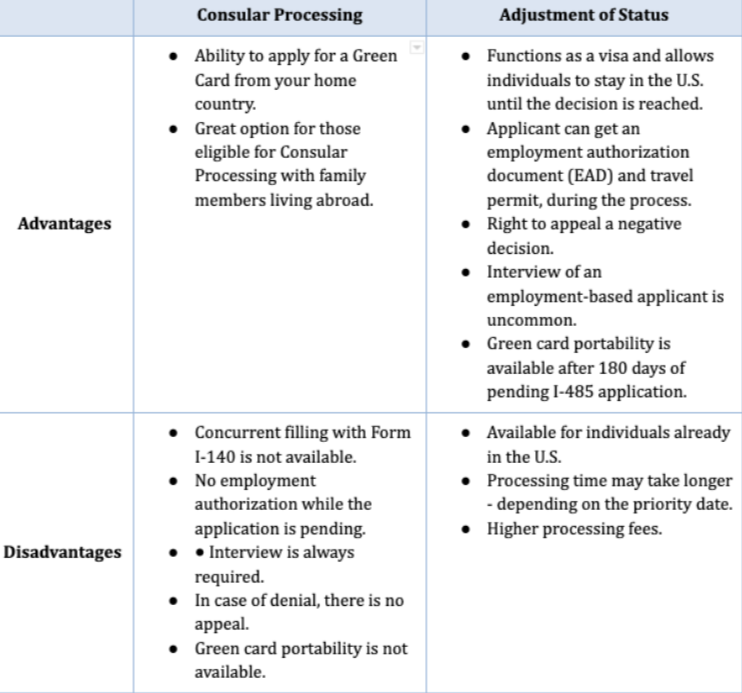Consular Processing vs. Adjustment of Status – What’s the best option to get a green card from an immigrant visa?
If you are ready to embark on your U.S. immigration journey but are uncertain about which path to follow or what distinguishes them from one another, don’t worry. You have landed in the right place.
There are 2 distinct ways to get an immigrant visa – consular processing and adjustment of status (AOS).
If you are a foreign national living outside the United States and want to obtain an immigrant visa, you must go through consular processing.
However, suppose you already live in the United States with a different type of nonimmigrant visa. In that case, you have the option to either apply for an immigrant visa through consular processing or adjust your status without leaving the country.
We understand that the immigration process can be an overwhelming and complicated experience. This article aims to provide you with clear differentiation between adjustment of status and consular processing to assist you in making a more informed decision.
Adjustment of Status or Consular Processing – The choice
Before deciding between adjustment of status and consular processing, it is essential to comprehend the distinctions between the two processes.
It is also essential to note that only some can choose between the two. Only a small fraction of prospective immigrants have the option to decide whether to pursue adjustment of status or consular processing.
The eligibility criteria for adjustment of status are stringent and restrictive, which narrows down the number of applicants who may qualify for this process.
In general, to be eligible for adjustment of status, the applicant must have entered the United States through lawful means, and there must be an immediately available visa.
However, only immediate relatives such as spouses, unmarried children under the age of 21, and parents of U.S. citizens are guaranteed visa availability. As a result, it is usually only immediate relatives who reside in the U.S. that have the option to adjust their status.
It is essential to note that visa availability is crucial in determining whether an individual is eligible to adjust status.
Individuals seeking employment-based permanent residence, commonly known as the “Green Card,” have two options to apply for permanent residency.
The first is Adjustment of Status, where the applicant submits their application while staying in the U.S. The second option is Consular Processing, where the applicant applies for an immigrant visa in their home country.
It is essential to weigh each method’s advantages and disadvantages before deciding.
Adjustment of Status allows the applicant to remain in the United States while waiting for the application to be processed, which can benefit those who do not want to leave the country.
However, Consular Processing may be more straightforward but is also lengthier than Adjustment of Status, and it can be a better option for those who are not eligible for Adjustment of Status.
Although processing time is a significant factor for many applicants seeking permanent residence, there are other considerations. While determining the quickest method is essential, other factors should also be evaluated when deciding which path to take.
Living abroad – Consular Processing
Consular processing is a process that enables a beneficiary of an approved immigration petition, whether it is family-based, employment-based, or another type of petition, to apply for a visa through a U.S. consulate or embassy located outside of the United States.
This means that individuals already approved for immigration status can apply for a visa at a U.S. consulate in their home country or another country where they have legal residence.
The consulate will evaluate the application, and if approved, the individual will receive an immigrant visa to enter the U.S. as a permanent resident.
Consular Processing Eligibility
The initial step in consular processing is to assess if you meet the eligibility criteria to file a Green Card application.
There are various ways in which individuals become eligible to apply for a Green Card. The most common is through a family member or employer filing a petition on their behalf. Some individuals may also become permanent residents by self-petitioning or through other special provisions that grant them the right to apply for a Green Card.
Determining eligibility is crucial to ensure you have the necessary documentation and support to proceed with the application process.
Filing the immigrant visa application
After determining the appropriate category that matches your circumstances, the next step is to submit your application to the United States Citizenship and Immigration Services (USCIS).
If you want an employment-based Green Card, you must file Form I-140 (Petition for Alien Worker). This form is used to formally request the USCIS to classify a beneficiary as eligible for an immigrant visa based on employment. For EB1-A Alien of Extraordinary Ability and EB-2 NIW, the application can be self-petitioned. For other employment-based immigration categories, you will need to have an employer sponsor to file the I-140 petition.Another way to obtain a Green Card is through family sponsorship. If you have a family member who is a U.S. citizen or a lawful permanent resident, they may be able to sponsor you for a Green Card. To begin the process, the U.S. citizen or lawful permanent resident family member must file Form I-130 (Petition for Alien Relative) on your behalf.
Waiting for immigrant visa processing and decision
Once the I-140 is approved and if you reside outside the U.S. (or choose to apply for your immigrant visa abroad), the approved petition will be forwarded by USCIS to the National Visa Center of the Department of State. The National Visa Center will hold the petition until an immigrant visa number is available and your priority date becomes current.
The National Visa Center Notification
The National Visa Center (NVC) plays a crucial role in the Green Card process for those living outside the United States or wanting to apply for an immigrant visa abroad. One of the critical responsibilities of the NVC is to collect visa application fees and supporting documentation from the applicant.
Once the USCIS approves the petition for a Green Card, the NVC will be notified and inform the petitioner and beneficiary that the petition has been received. The NVC will then update the petitioner and beneficiary, telling them when an immigrant visa number is about to become available.
At this point, the NVC will inform the beneficiary that they must submit immigrant visa processing fees and supporting documentation. This documentation typically includes forms, passports, civil documents, and other necessary paperwork for the immigrant visa application process.
The Consular Interview
Once an immigrant visa number becomes available or your priority date is current, a consular officer will schedule your visa interview and notify you of the interview date, place, and time.
Once your interview is scheduled, it is important to undergo a few steps before your interview. One of these steps is a Medical Exam. You will need to undergo a medical exam by a USCIS-approved doctor. You can find a list of approved doctors and further information on your local U.S. embassy or consulate’s website. Once the appointment is scheduled, remember to bring your green card interview appointment letter with you. After the medical exam, the doctor will hand you out sealed Form I-693 (Report of Medical Examination and Vaccination Record). You should bring both unopened to your interview.
The consular office will then begin to process your case, which involves reviewing your application and conducting an interview to determine if you are eligible for an immigrant visa.
It’s essential to be prepared for the interview and to bring all necessary documents and evidence to support your case. The consular officer may request additional information or documentation, so following their instructions is essential.
If the consular officer approves your application, you’ll be issued an immigrant visa and can travel to the United States to begin your new life as a permanent resident. However, if your application is denied, you can appeal the decision or reapply later, depending on the circumstances.
Congratulations! Your visa was approved
If your application for a Green Card is approved, the consular officer will provide you with a Visa Packet containing important information related to your immigrant visa. Keeping this packet safe and unopened is essential until you arrive in the United States.
Before departing for the United States, you must also pay the USCIS Immigrant Fee. The fee is utilized for processing your immigrant visa package and issuing your Green Card. We recommend paying this fee online after receiving your visa packet to ensure your Green Card is processed on time.
When you arrive in the United States, it is necessary to show your Visa Packet to the Customs and Border Protection (CBP) officer at the port of entry. The CBP officer will inspect to determine if you meet the criteria for admission into the country as a lawful permanent resident.
Assuming the CBP officer allows you to enter the United States, you will be granted lawful permanent resident status.
The most anticipated moment of all – receiving the Green Card
After paying the USCIS Immigrant Fee and arriving in the United States, you can expect to receive your Green Card in the mail. It may take up to 90 days from the date you entered to receive your permanent resident card.
However, if you do not receive it within 45 days of your arrival, it’s essential to contact the USCIS Contact Center at 800-375-5283 to inquire about its status.
Living in the United States – Adjustment of Status
The Adjustment of Status is a procedure that allows people to request permanent resident status, commonly known as applying for a Green Card while living in the United States.
The adjustment of status applicant must meet the eligibility criteria for a Green Card. If approved, you can live and work in the United States.
Applying for a Green Card involves completing at least two primary forms in the application process. These forms are the immigrant petition and the Green Card application.
Employment-based adjustment applicants must file Form I-140, and family-based applicants Form I-130. Both need to file Form I-485 (Application to Register Permanent Resident or Adjust Status), the application form used to request an adjustment of status and obtain a Green Card.
The adjustment of status application – Form I-485
When a visa number is available, an applicant can file Form I-485, also known as the Application to Register Permanent Residence or Adjust Status, concurrently with the immigrant petition. This means that the applicant can process both applications together, saving time and reducing processing delays.
A priority date is assigned to an applicant based on their place in line for a visa, determined by the date the immigrant petition was filed. If the demand for visas in a particular category exceeds the supply, a backlog can occur, and the priority date can move slowly or even retrogress. However, if an applicant is subject to immigrant visa backlogs, they may not be able to apply for adjustment of status until their priority date becomes current.
In this situation, the applicant will have to wait until their priority date becomes current before filing the adjustment of status. Alternatively, they may choose to consular process their Green Card application outside the U.S.It’s crucial to stay up-to-date with the monthly Visa Bulletin, which provides information on priority dates and visa availability, to determine when an applicant can file for adjustment of status.
Biometrics and Adjustment of Status Interview
Once you submit your Form I-485, USCIS will send you a notification containing information about your biometrics services appointment at a local Application Support Center (ASC). At this appointment, you will need to provide your fingerprints, photograph, and signature, and the notice will indicate the appointment’s date, time, and location. This process aims to confirm your identity and carry out necessary background and security checks.
During your ASC appointment, we will request you to sign an acknowledgment certifying that you have thoroughly reviewed all the information in your application and that the information you provided was accurate, complete, and valid at the time of submission. In case you don’t sign the acknowledgment or miss your ASC appointment without notifying the appropriate authority and requesting a reschedule, there is a possibility that your Form I-485 application may be denied.
USCIS officials will carefully evaluate your case to determine if an interview is required. If an interview is deemed necessary, you will be requested to attend an appointment at a USCIS office where you will be asked to answer questions while under oath or affirmation regarding your Form I-485. A notice containing the interview’s date, time, and location will be sent to you.
The Adjustment of Status Decision
After reviewing your application, USCIS will send you a written decision notice.
If your application is approved, you will receive an approval notice first, followed by your actual Permanent Resident Card (Green Card) at a later date.
If your adjustment of status application is denied, you will receive a notice stating the reason(s) for the rejection and whether you can file an appeal. Typically, denials cannot be appealed, especially if the cause is due to ineligibility for adjustment of status. However, even if an appeal is not an option, you may still be eligible to file a motion to reopen or reconsider using Form I-290B, Notice of Appeal.
Things to Consider when Traveling During Adjustment of Status
When your adjustment of status application is pending, it is essential to know that it acts as a visa, allowing you to stay in the United States while it is being processed. However, this does not guarantee your ability to return to the U.S. if you travel overseas.
To ensure your ability to reenter the U.S., you must file Form I-131 (Application for Travel Document) to obtain advance parole.
This document allows you to leave the country and return to the U.S. upon reaching the border. Failure to obtain advance parole before leaving the U.S. can result in the abandonment of your application to adjust your status.
Advantages and disadvantages of Consular Processing and Adjustment of Status
The following chart may help you consider the adjustment of status and consular processing and help you make the best choice between the two, according to the most appropriate for their specific situation.

Conclusion
It’s essential to understand that there is no universal answer when deciding between adjustment of status and consular processing. Each approach has advantages and disadvantages, and the better option for you will depend on your specific situation, such as your immigration status, family members, job type, and travel history.
Therefore, it’s crucial to consult with an experienced immigration team who can analyze your case comprehensively, consider your factors, and provide tailored recommendations. This can help you make an informed decision that suits your needs and goals while avoiding potential issues or delays in your immigration process. Need a winning immigration strategy? Contact us!
* This article is for informational purposes only and does not provide direct legal advice.
FAQ:
What are the significant differences between Adjustment of Status and Consular Processing?
Adjustment of Status is a process in the United States, whereas Consular Processing occurs at a U.S. consulate or embassy. Generally, Adjustment of Status is faster than Consular Processing. If an applicant chooses to apply for Adjustment of Status, they may also apply for travel and employment authorization benefits, known as EAD, and Advance Parole. However, these benefits are not available through Consular Processing. Consular Processing requires the submission of police certificates from all countries where the applicant has lived for at least one year, an interview, and a medical exam. On the other hand, Adjustment of Status requires fingerprinting and a physical examination by a USCIS-approved physician within the United States.Can I adjust my status on a tourist visa?
People who visit the country for tourism or short-term purposes usually obtain a nonimmigrant visa, as they have no intention of staying permanently and must leave before their authorized stay expires. A nonimmigrant visa is only applicable for temporary stays in the United States. Immigrant visas are only used to adjust one’s status in the United States. However, the 90-day rule should be kept in mind, as adjusting your status within the first 90 days of your stay in the U.S. is generally not advisable.What is the process to change from adjustment of status to consular processing?
If you initially choose consular processing to obtain an immigrant visa on your petition (Form I-130), you still have the option to apply for an adjustment of status. Assuming you meet the eligibility requirements, you can file Form I-485, Application to Adjust Status, with the United States Citizenship and Immigration Services (USCIS) even if you previously opted for consular processing. Upon receiving your application, USCIS will recall your case from the National Visa Center, responsible for processing immigrant visa applications for consular processing. This option gives applicants more flexibility to choose the appropriate pathway toward obtaining their permanent residency in the United States.What is the process to change from consular processing to adjustment of status?
To switch from the consular processing route to adjust status to permanent residence, you must first meet the eligibility requirements for an immigrant visa. After completing the necessary paperwork and moving to the United States, the applicant may apply to adjust the status with the USCIS. However, it’s essential to remember the 90-day rule, which advices against adjusting your status within the first 90 days of your stay in the U.S. This allows USCIS to verify your eligibility and process your application accordingly. Once approved, you can obtain permanent residency in the United States without needing consular processing.What happens if my I-140 is approved but my priority date is not current?
If your I-140 is approved, but your priority date has not yet become current, your application will be put on hold and kept on file with the National Visa Center until your priority date becomes current. It’s essential to keep track of your priority date and stay up-to-date on any changes or updates to the immigration process that may affect your application. Once your priority date becomes current, the National Visa Center will notify you on how to proceed with consular processing. Your file will then be forwarded to the appropriate consular post, where you will attend an interview and complete the remaining steps necessary to obtain your immigrant visa.









